Description: War Thunder is a next generation military MMO game dedicated to...

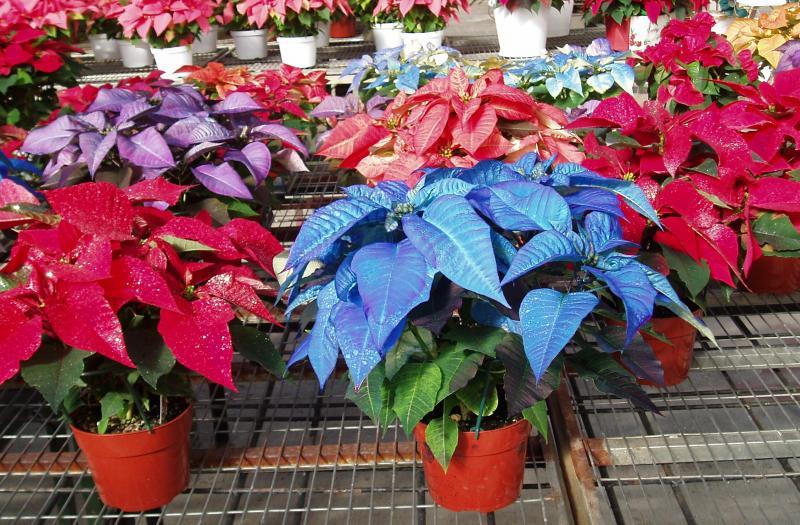
With the advent of winter, most indoor plants falls into "hibernation", and only some species in cold, frosty days please with beautiful and bright colors filling the room with comfort and giving good mood. One of these species is the "Christmas Star" or poinsettia from the numerous Euphorbiaceae family. « Christmas star "- a flower, the care of which will not seem too easy, but for patient and attentive lovers of beauty, there are no difficulties.
No wonder the poinsettia is called the "Christmas star", because it blooms in December, on the eve of Catholic Christmas. Her flowers are small, yellow-green in color, look like small buttons, but bract leaves give them beauty. They are elegantly painted in red, peach, pink or cream shades.

"Christmas Star" - care for this fabulous and mysterious plant should begin with the lighting regime. The flower prefers bright Sun rays but diffused through light tulle or film. Lack of light threatens to fall off the leaves.
For the poinsettia to bloom new year holidays, you need to use a little trick. For the successful formation of buds, a reduced daylight hours is required, no more than 10 hours. Therefore, starting from September, it is recommended to cover the "Christmas star" with a cap made of thick cardboard, felt, or take it to a dark room. This mode must be maintained for at least 8 weeks, after which you can return to the conditions of detention familiar to her.
Caring for a "Christmas star" flower is complicated by the fact that each phase of a plant's life requires maintaining a certain temperature:
Poinsettia does not tolerate cold, sudden changes in temperature and drafts. Therefore, purchasing it winter time years, you need to take good care of transportation, even a short stay in the cold is detrimental to the pampered "star".
In summer, in sunny days the flower can be taken out to open verandas or balconies, but make sure that the leaves do not get burned.
In the summer, when the air temperature is elevated, it is recommended to water the plant abundantly, between procedures the topsoil should have time to dry out. With the onset of flowering, watering is gradually reduced, and after the last inflorescences have withered, they try not to water at all. You can spray the soil to keep it moderately moist. At the end of the rest period, with the growth of new leaves, the care of the "Christmas star" and the frequency of watering are resumed.
Poinsettia prefers slightly acidic soils, pH no more than 6.0. The optimal composition of the mixture for growing:
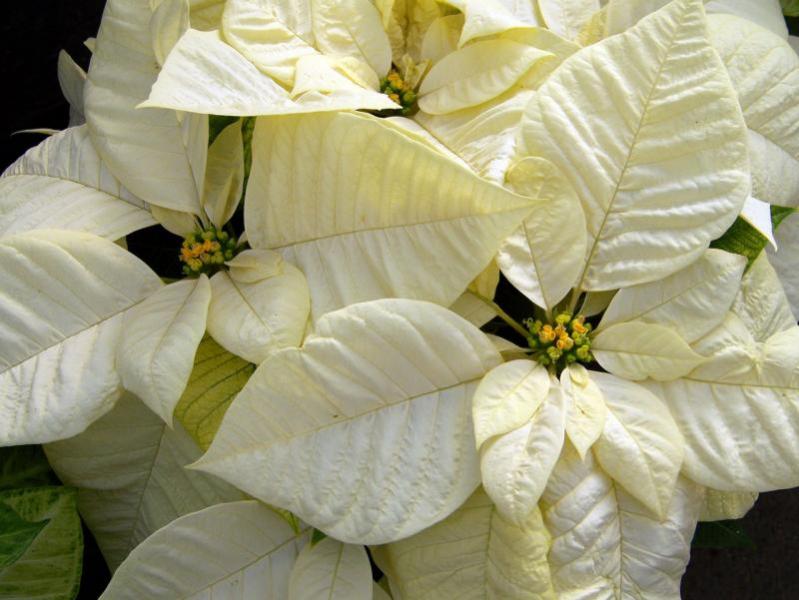
Be sure to prepare drainage from small pebbles, broken bricks or expanded clay.
Flower care "Christmas star" provides for top dressing, but procedures should be carried out only during the active growth of new shoots and before flowering, that is, from May-June to December. You can alternate organic and mineral fertilizers, they should be applied only after watering and no more than 1 time in 14 days. From mineral-containing compositions, universal complex fertilizers are suitable for decorative flowering houseplants.
As a rule, the plant blooms until March, after which it needs rest. At this time, the poinsettia drops the bracts and the task of the grower is to cut the branches as much as possible, not less than 1/3. After that, watering should be reduced as much as possible, and the pot should be placed in a cool room without bright lighting. So the "Christmas star" will restore its strength for 6-8 weeks. As soon as dormant buds begin to awaken and young shoots appear, it is advisable to transplant the bush into a fresh substrate.
Advice! In order for the “Christmas star” to always look neat and well-groomed, it is recommended to trim Special attention, weak and "bare" branches need to be cut lower, stimulating the growth of new side shoots.
The plant has very sensitive and delicate roots, so it is recommended to use the transshipment method instead of transplanting, without clearing the roots of the old substrate. It is enough to replace the drainage and the topsoil, for young specimens you can pick up a new pot, a slightly larger diameter.
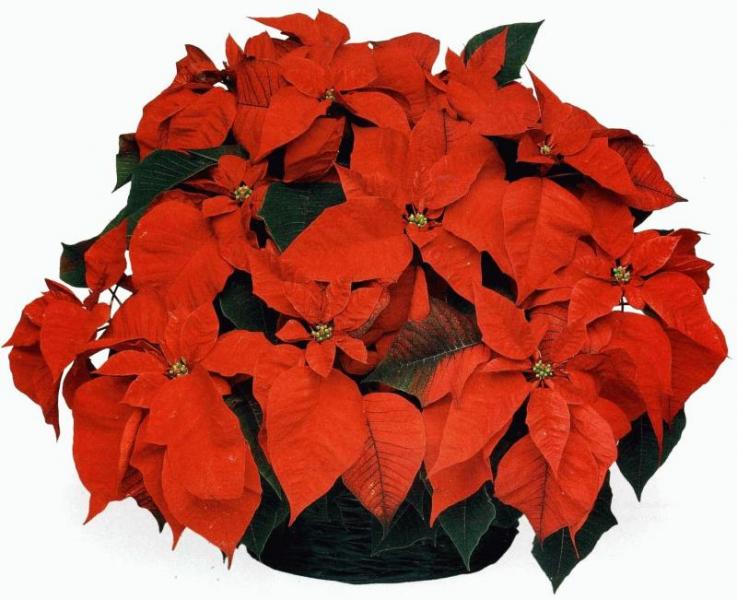
After transplantation, it is necessary to provide special care for the "Christmas star": the air temperature is not less than +21 ° C, plentiful and frequent watering, spraying. Soon young shoots will appear on the bush, it makes no sense to leave everything, you should choose only the strongest and strongest, and cut the rest and use them as cuttings for propagation.
The cut stalk must contain at least 4 internodes. Its cut must be powdered with charcoal and only then planted in a small container filled with a nutritious but loose substrate. Peat mixed with river sand in equal proportions is best suited. When cutting the shoot, you can find white juice, it should be blotted with a napkin, as it tends to clog the pores of the stem, which often leads to decay of the cutting.
It is better to immediately cover the container with the plant with a polyethylene "cap" and provide it with greenhouse conditions; for successful rooting, an air temperature of +24 ° C is required. Periodically, the "greenhouse" needs to be ventilated, and the stalk should be sprayed and moistened with soil.
Attention! Poinsettia juice is very poisonous, after working with the plant you need to wash your hands thoroughly or use gloves.
Caring for the "Christmas star" flower should be very careful, because the deterioration of the conditions of detention immediately leads to the withering of the plant or the dropping of leaves. As a rule, this happens due to hypothermia, drafts or improper watering.
Most often, poinsettia is attacked by pests such as mealybugs. These are small whitish insects that can quickly spread throughout the plant, feeding on its juice, and leaving a sticky coating on the surface of the leaves. If measures are not taken in time, then the flower will stop growing, and will soon wither and die. It is best to wipe the leaves of the plant with a solution of laundry soap or alcohol. For greater effect, you should use proven chemicals: "Commander", "Tanrek", "Fitoverm" and others.
Perhaps, at first glance, the "Christmas star" will seem too capricious and demanding, but how nice it is to receive a gift for the New Year in the form of bright and flowering indoor plants grown with love and care.
What is Poinsettia Succulent? - one of the few plants that bloom in winter. It blooms in December, so it is widely used to decorate houses and premises before Christmas (in Europe and the USA).
Due to the fact that the flower is a Christmas symbol, they began to call it Star of Bethlehem and Christmas Star. bright and unusual view The Russians also liked the plants.
In contact with
The birthplace of the flower is tropical Mexico, cities of Central America (Costa Rica and Guatemala).
The Aztecs, living in tropical Mexico, considered the poinsettia a symbol of purity (because it grows in compost heaps). They also used the plant in their rituals.
From the end of November small green formations appear at the very tops. They look like small buttons and show through more and more every day - these are blooming poinsettia flowers. Throughout the autumn and December, bracts grow, which are spirally arranged.
On Christmas Eve the bracts are no longer pale, but bright red, which gives the plant a festive look. In January, having reached its maximum size, the bracts turn pale again and fall off.
The plant is then transferred to a resting position.
Some owners of this plant throw it out after the first flowering. Seeing a lifeless stem, they think that the flower has died or they simply do not know how to take care of it. Forcing in greenhouses poinsettia tolerates a little worse than home care.
Photo of beautiful poinsettia flowers.

Succulent Poinsettia - It is a shrub from the Euphorbiaceae family., with empty erect stems and bright green leaves (about 12 cm long). They are attached to the trunk with red-orange stems.
Poinsettia blooms with light yellow-green small flowers that frame white, cream, pink and red bracts. Coloring and small size (grow no more than 40-50 cm in height) give the plant a festive look.
All varieties appeared during the selection of the most beautiful poinsettia, so they all look alike.
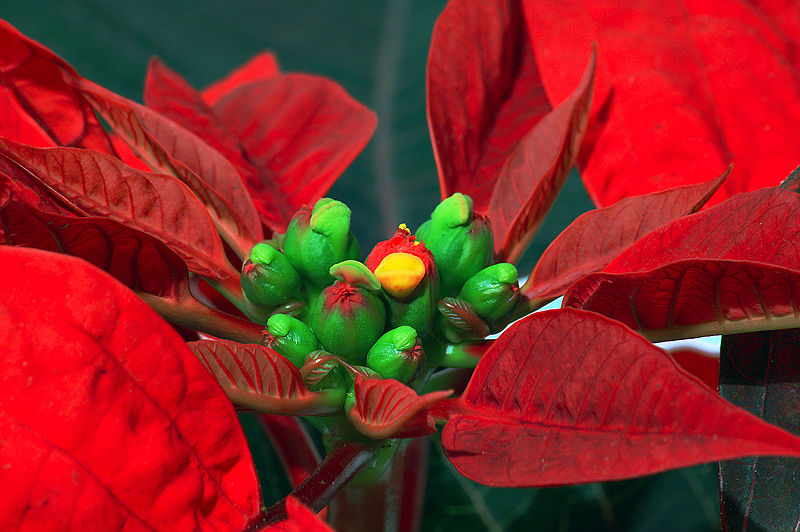
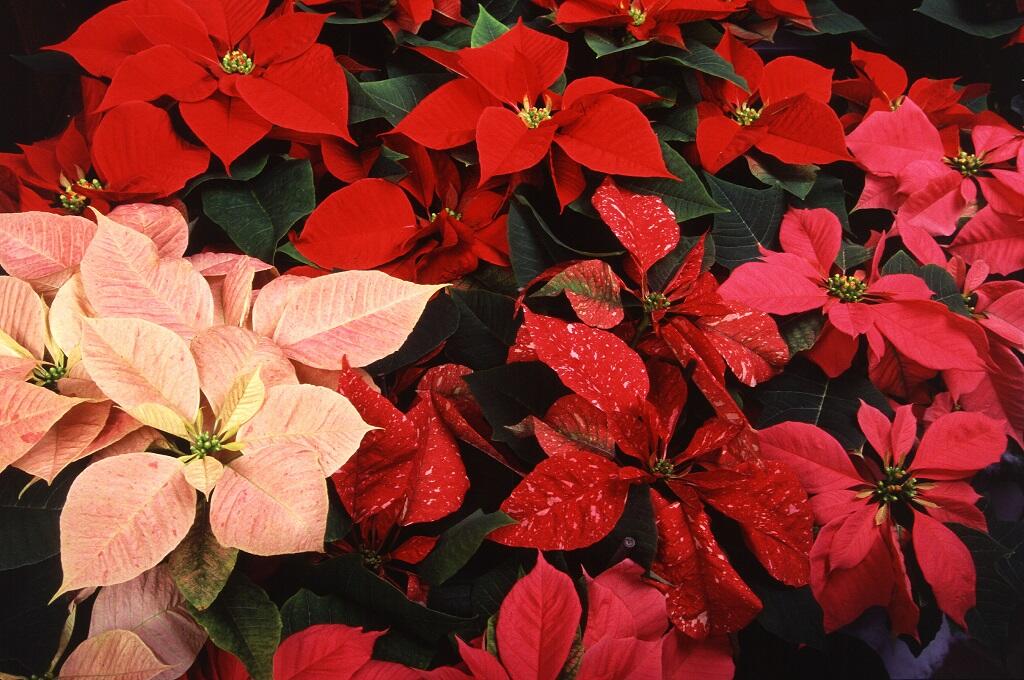
The bracts are 10–15 cm long, 6–8 cm wide, and have a flowering diameter of 20–30 cm. Bright red color bracts:
Photo of a beautiful poinsettia flower with red bracts.
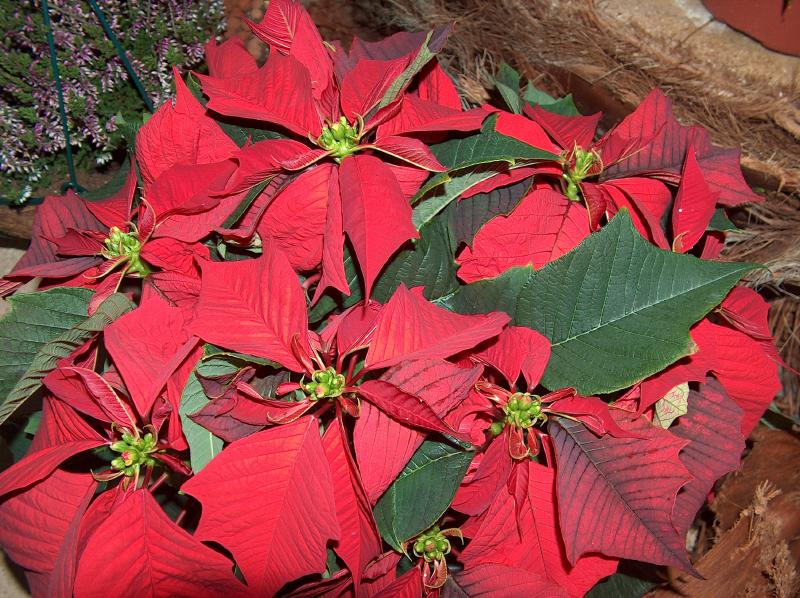
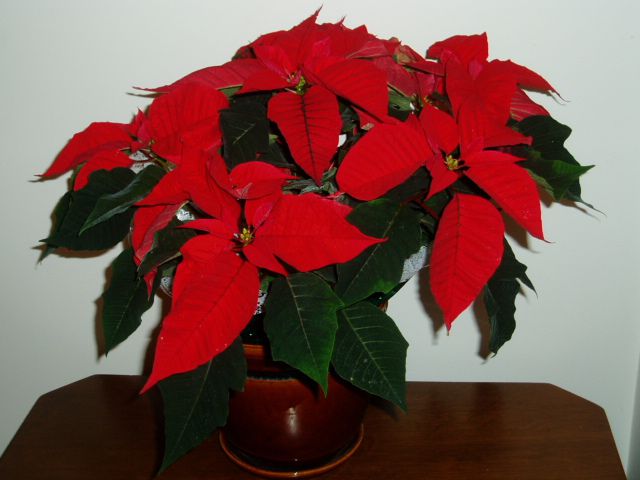
Bracts are small, 6–10 cm long and 3–5 cm wide. Flowering is from 15 to 20 cm. Colors of bracts pale pink:
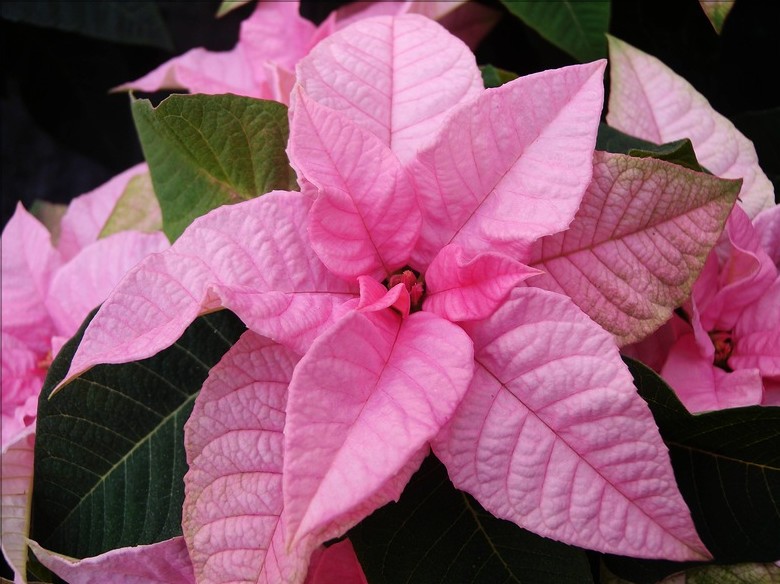

The length of the bracts is 6-10 cm, and the width is 3-5 cm, the bundle is 15 to 20 cm in diameter. Bracts white color:

The length of the bracts is 6-10 cm, and the width is from 3 to 5 cm, the diameter is 15-20 cm. Bracts cream color:
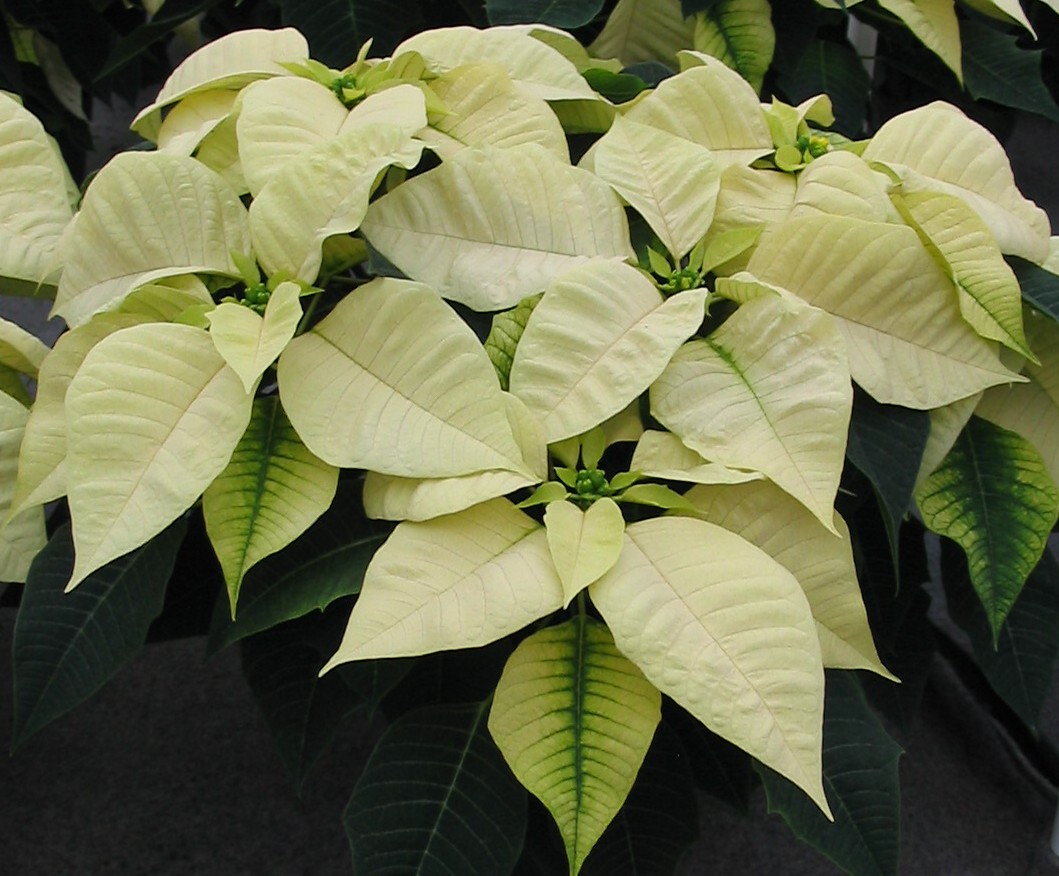
Bracts can also be of other colors, bicolor, as in Jungle Bells and colorful(with veins, edging).

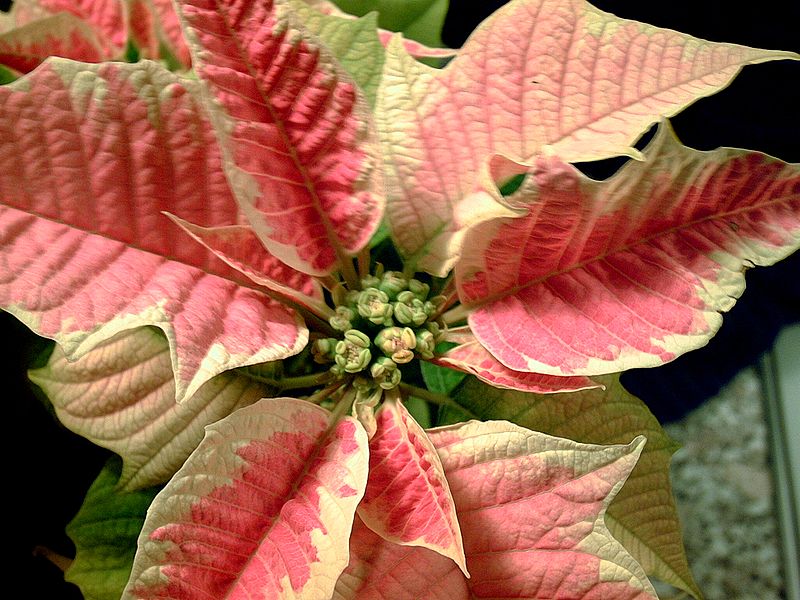
How to care for the most beautiful poinsettia flower (Christmas star or the most beautiful euphorbia)? How to propagate, transplant, prune and other questions. Consider the main nuances of reproduction and care for poinsettia flowers at home (photo and video).
in winter The plant needs a lot of bright light. If you plan to leave the flower for another year, then you need to shade it a little. The plant loves light, but it is impossible to stay in the sun for a long time at once. You need to accustom several hours a day to avoid burns.
At the beginning of autumn poinsettia should be removed from the light in the shade for 12-14 hours (you can even put the pot in a bag) This should be repeated every day until the end of autumn.
Summer The poinsettia feels comfortable at 20-25°C. You can leave the plant outside, but be sure to protect it from drafts.
in winter it is impossible that the temperature environment did not fall below 16 ° C (at t ° C less than 10-12 ° C, the plant dies).
If you maintain a temperature of 15 ° C during flowering, then it will be longer.
Watering should be moderate(about twice a week). Do not allow the soil to dry out, but do not flood the flower (watered when the soil begins to dry out a little). Leaves should not be sprayed with a spray bottle to avoid staining. It is enough just to humidify the surrounding air.
in winter, when kept in a low-temperature environment, the frequency of watering is greatly reduced (1 or 2 waterings per month). Take water not cold, but at room temperature.
Leaves need to be sprayed only during flowering. Humidity must be high. The rest of the time - moderate.
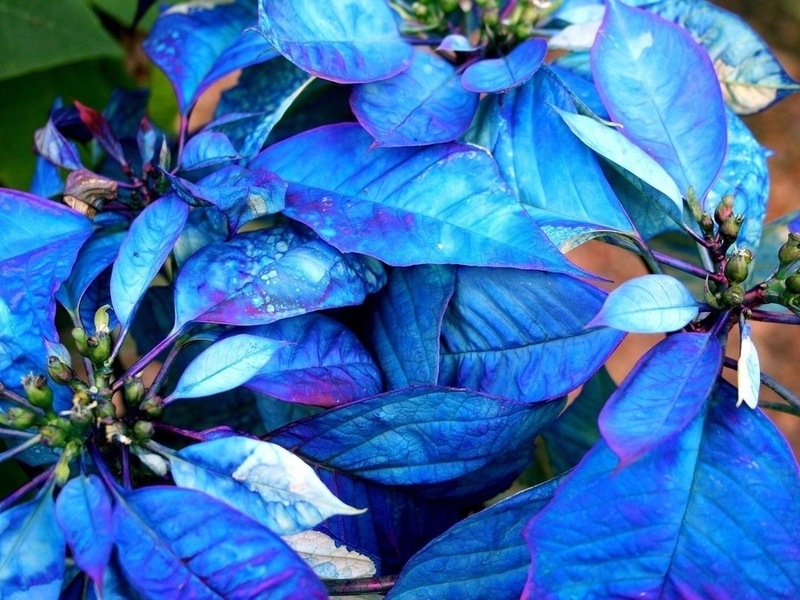
Feeding mixes:
Feeding is carried out with a frequency of 14 days April to December. The plant remains without a substrate for only three months.
The flower is not fed only during the period of flowering and growth.
The poinsettia loves loose, nutrient-rich soil (fertilized) with a neutral acidity level. Ideal soil option similar to feed mix No. 4 (turf, peat, leaves, earth, sand in a ratio of 1:1:1:1:1)
From January The poinsettia succulent is at rest. Plants overwinter in a moderately warm and dry place.
In March bare stems should be trimmed. In May, the stems are cut again, leaving only 10 cm in height.
They do it once every few years. It's done after a period of rest - in May.
When new shoots appear, they should be cut off (leave 6 large ones).
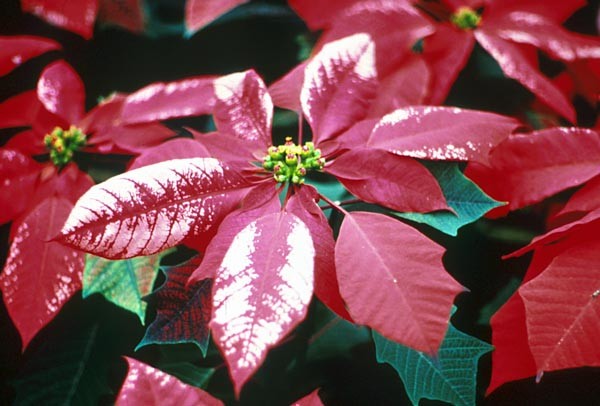
AT wild nature plant reproduces by seeds at home content - cuttings. The period is spring and early summer.
Shoots that have been removed from the transplanted plant can be used as propagation cuttings. Rooting occurs in a month, flowering - in a year.
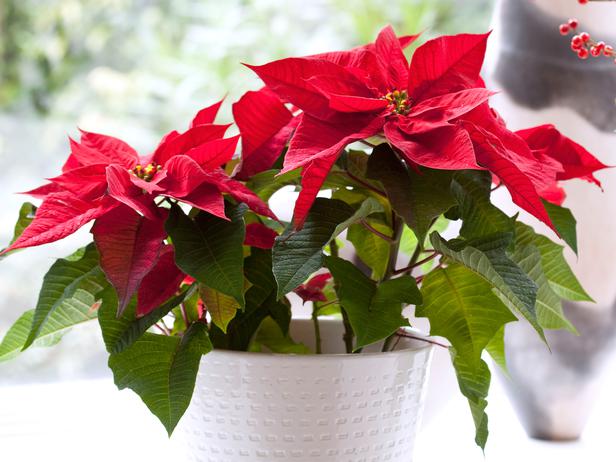
Pests:
Diseases:
Do not leave apples and pears near the flower. From their influence, the Christmas star fades.
It is not worth buying and moving a plant along the street in winter. Euphorbia is the most beautiful getting used to a new place in 21 days.
He is quite naughty and reacts sharply to environmental changes. Dislikes hot and cold weather. Also the Christmas star is changeable to sunshine- at one time of the year you need a lot of it, at another - it is limited by the hour.
Please help us make the site better! Leave a message and your contacts in the comments - we will contact you and together we will make the publication better!
The houseplant "Christmas star", better known as the most beautiful spurge or poinsettia, came to us from Central and South America. This is a perennial shrub with a bare erect dark green or brown stem with large broad leaves 10-15 cm long, producing small yellow flowers on bright red (rarely yellow) star-shaped bracts.
In this article, we will look at how to properly care for the Christmas star flower in order to achieve a long and beautiful annual bloom.
This flower needs an annual transplant, which should be carried out in the spring - from April to May.
How to transplant the "Christmas star":
Cropped sprouts can be used for propagation.
In order for this flower to bloom on time, namely for the New Year and Christmas, during the autumn (October-November), it must be covered with a black film or an opaque cardboard box in order to reduce its daylight hours to 10 hours. And in early December put in  warm room (about 18°C) with bright lighting and start watering heavily.
warm room (about 18°C) with bright lighting and start watering heavily.
If you do everything right, then by Christmas the Christmas star bush will become even more magnificent and delight you with its unusual flowers.
The main problem in growing a "Christmas star" at home is that it leaves fall. This is due to an excess of moisture, temperature changes in the room, or the pot being in drafts.
Often people who bought a “Christmas star” flower for the winter holidays for some reason believe that it will no longer bloom, but with the proper care described in our article, it will delight with its unusual flowering for several more years in a row.
Foreword
The historical roots of this plant originate in Mexico and Central America. The poinsettia flower or, as it is also called, the most beautiful euphorbia is really the most beautiful representative of the flora. But caring for a plant is not easy.
This beautiful plant in adult form in room conditions reaches about half a meter in height. But in their native lands, this green shrub can grow up to 4 meters. However, they appreciate it not for its size, but for the original elliptical shape of green leaves with denticles along the edges and bright red bracts. Red color is found in all sorts of varieties most often, but thanks to selection, scientists managed to get more unusual shades - pink, snow-white, yellowish and even two-color bracts are increasingly found in specialized stores.


By the way, the flower is not a random name. The plant was named in honor of Joel Poinsett, who was a botanist at heart, but in reality the first American minister of Mexico. However, the more common name of the poinsettia is associated with the flowering period - because of the characteristic shape of the buds, it is also called the Bethlehem or Christmas star.
Such associations are also caused by the fact that the buds usually bloom at Christmas. Do not confuse the poinsettia flower with the Christmas tree () - these are completely different indoor plants. These indoor flowers are both annuals and perennials - if you follow proper care, then an unpredictable poinsettia from an annual flower can become a perennial. In order for home flowers to please you every year bright colors and flowering, you need to stop the usual care and go to - the poinsettia signals its beginning with fallen leaves.
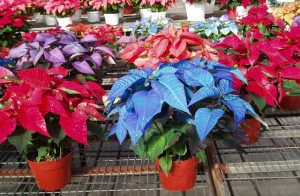
You should also stop during this period and fertilize the plant. Until May, these indoor plants "sleep", which is often mistaken for symptoms of the disease due to inexperience. It is better that they are at this moment in a cool and dark place.
In autumn, you need to pick up a small box that does not let in light. In it, your flowers should be about 14 hours a day. By spring, after a temporary hibernation, as soon as the poinsettia flower begins to grow, it will need to be transplanted into a new soil. And keep in mind that the juice that this plant secretes when cut is poisonous! When working with this plant, you need to be careful with your eyes, also be prepared for the fact that an allergic reaction may occur due to careless contact. To care for this flower does not turn into torture, be sure to wear gloves.
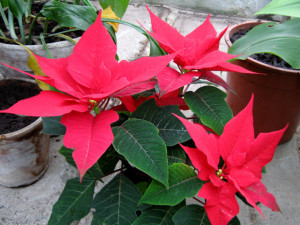
These indoor flowers, bewitching from a distance, are very fond of comfort, as well as special care. At first, place the pots on the windowsills, but in such a way that the direct rays of the sun and drafts bypass the poinsettia. For optimal growth of this flower, it is desirable to provide a constant temperature regime around 19–24 ºC. If the flower is dormant, then it is advisable to lower the temperature to 14 ºC. Care at this time is very moderate watering. The first dressings are applied in the spring and continue to supply the plant with nutrients in the summer and autumn twice a month.
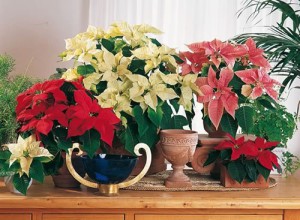
The poinsettia needs pruning of the stem - it is produced at about 15-17 centimeters in height in early April. For the flower to grow green mass, at the end of spring, they begin to feed it with fertilizers, water it intensively and put it in a lighted place. Do not worry, such care is completely justified - soon the flower will have new shoots. Potash and complex fertilizers will only benefit your flower during this period. By the way, you can transplant a plant in the spring, after it has had a good rest. When transplanting, do not forget about drainage.

Have you ever experienced unbearable joint pain? And you know firsthand what it is:
Now answer the question: does it suit you? Can such pain be endured? And how much money have you already "leaked" for ineffective treatment? That's right - it's time to end this! Do you agree? That is why we decided to publish an exclusive interview with Professor Dikul, in which he revealed the secrets of getting rid of joint pain, arthritis and arthrosis.
Poinsettia is called the "Christmas star", and the type of plant is called "Euphorus the most beautiful", it blooms in winter, when other indoor flowers do not indulge in this. This spectacular spurge cannot be called a capricious indoor flower, you just need to know how to care for it at home.
At home, this tropical plant develops as evergreen shrub, grows from one and a half to four meters tall. And at home, we grow hybrids no more than 30 - 40 cm tall. At the beginning of winter, Poinsettia indoor plants attract attention on the shelves of flower shops with noble dark green foliage of an ellipsoid or ovoid shape with an elegantly carved edge, a bright red rosette, for which the plant was nicknamed the "Christmas star". These are not flowers, but just stipules, which constitute the main decorative value, the flowers will bloom a little later - nondescript, yellowish, collected in small rosettes.
At home, the poinsettia leads the life of an evergreen, but she definitely needs a dormant period, during which she sheds almost all the leaves. Then comes a period of intensive growth, as a rule, it falls on the summer, in the fall the plant prepares for flowering. This is the lifestyle indoor flower Poinsettia almost all year, with the exception of a few months of late winter - early spring, it looks beautiful, but with a bright crown. The natural color of the stipules during flowering is bright red, but the breeders did their best, now you can find flowers with milky white, pink, orange, lilac, blue, two-tone color.
From the video you will learn how to grow a poinsettia flower.
Poinsettia care at home prefers not too burdensome, but caring. She really does not like drafts, air currents, regardless of its temperature, does not like temperature fluctuations and dry air, if she is not protected from such troubles, she will get sick, lose her leaves.

And if you create the necessary lighting regime for her at home, a comfortable temperature and humidity, treat her need to lose and grow leaves with understanding, feed when necessary, water as much as necessary, replant and prune every spring, this beauty will show you why the view is called "Euphorus the most beautiful."
The poinsettia does well on any window sill, except for the southern one, because it likes diffused light, and direct sunlight can cause a burn, to the point that the leaves get Brown color, dry up and crumble. During flowering, she needs a lot of light, since in winter we have rather little of it, we often have to turn on fluorescent lamps to lengthen the daylight hours and make it brighter. If there is little light, the stipules may turn pale, lose their confident bright color. 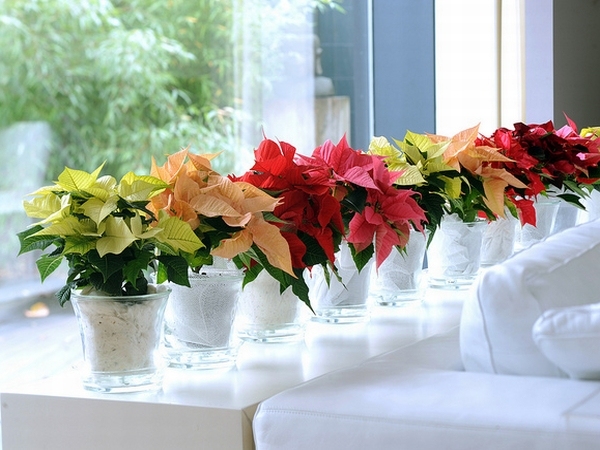
A lot of light is needed when the plant begins to grow intensively after a dormant period, in the summer there is usually enough sun. Very little light is needed during rest, but the flower should not be taken out into the closet or hidden in the cellar, it is quite enough to put it away from the windows, in the hallway or some corridor where it will not catch the eye, because it will become completely unpresentable. A special attitude to light should be in autumn (September - October), when the plant is preparing for flowering. At this time, he needs to strictly limit the light in time and increase the darkness, just as in winter it is necessary to increase the illumination.
Like most hybrids of tropical plants, this spurge at home does not like a lot of heat. The most comfortable temperature for him is in the range from +18 to +22 degrees. An increase in air temperature to +25 degrees Poinsettia will survive (especially if humidity is increased), but a decrease can be fatal. Only during the dormant period can the temperature drop to +14 or + 15 degrees, with the beginning of growth, the flower is immediately transferred to a warmer room.



Some flower growers advise, in preparation for flowering in the fall, to lower the temperature to the lower limit of the comfort zone. But practice has shown that at an air temperature of +20 - +22 degrees, the plant is perfectly prepared for flowering and blooms to the delight of its owners.
Watering should be sufficient - this is the basic rule. In summer, during intensive growth, the plant needs more moisture, this becomes noticeable by the rapid drying of the earth, in winter the earth dries out much more slowly. This means that watering in the summer should be much more frequent, preferably in small portions, so that the water does not stagnate, otherwise the roots may rot. During the dormant period, earthy who is simply not allowed to dry out, watering is rare.
In summer, when the air temperature rises and in winter, during flowering, the plant responds well to spraying. Poinsettia feels good at home with a humidity level of 60 - 70%.
When heaters are turned on, the dryness of the air rises especially, you need to remember this and help the tropical beauty with frequent spraying. Well, if moisture does not accumulate on the leaves, but hangs in the air in a small cloud, for this you need to use a small nozzle on the sprinkler. Too dry air provokes damage to the plant by a spider mite. It is better not to allow this, if it has already happened, then the plant must be thoroughly washed (repeatedly) using soapy water.
For watering and spraying, use only clean soft (settled) water at room temperature. If the water temperature is lower than the air temperature, then the flower may crumble.
top dressing
From the beginning of intensive growth, that is, from May to the end of autumn, the plant is fed twice every month with mineral fertilizers. Usually complex mineral fertilizers are used, but euphorbia also perceives organic fertilizers well. Many flower growers alternate mineral and organic fertilizers. Before the start of flowering, organics are stopped to be introduced, and from minerals, preference is given to those that are rich in potassium.
Some flower growers make top dressing until the end of flowering, others stop with its beginning. Some experts believe that during flowering it is not necessary to feed the Poinsettia if before that it received plenty of fertilizer. But, as usual, the decision is made by the owner of the flower himself.
Transfer
In winter, after flowering, the beautiful Poinsettia begins to lose leaves, it becomes no longer so beautiful, if a person does not know that this perennial plant is just preparing for rest, he might think that she is dying. But everything is not tragic at all, the flower has spent a lot of energy, he needs to rest and concentrate for later life. Therefore, he should be helped - cut off the shoots, leave only a twig 10 - 15 cm from the ground, remove from the bright window. You do not need to hide it far in a cold place, let the temperature be at the level of +15 degrees, watering is rare, but sufficient so that the earthen ball does not dry out.
After a few months, usually around the end of April, the plant will decide it's time to wake up. As soon as at least some activity is detected, it must be transplanted into a new soil. The pot is taken a little larger than the previous one, a drainage layer 2–3 cm thick is necessarily organized at the bottom. Then they fill up a little new soil, place the plant with an earthen clod (so as not to injure the roots), fill up the new soil from all sides. You can buy it in the store, palm soil is suitable, you can buy a universal one for indoor plants and add a little peat. And you can cook it yourself by mixing turfy, leafy soil with humus, peat and sand. The soil must be sour.
reproduction
At home, poinsettia can propagate with the help of seeds; at home, this method is not feasible. But it is very easy to propagate it by cuttings. Before the start of the dormant period, the plant is heavily pruned. The second time is cut at the very beginning of active growth to form a beautiful crown. After each pruning, branches remain that can be easily rooted.
Best for rooting is a cutting 7-10 cm long with several buds. If there are lower leaves, they are removed, the top few can be left. For a few minutes (from 5 to 30), it is advised to put a branch in water to remove the poisonous milky juice. After that, the stalk is dipped in a powder that stimulates the formation of roots (you can do without it), planted no deeper than 2 cm in wet soil. Can be rooted in a mixture of peat and sand. Dishes with a sprig (or sprigs) are covered with a plastic bag to create greenhouse conditions, keep warm in the light. The air temperature should be at least +20 degrees, maybe even a little higher. Sometimes you need to ventilate so that mold does not appear. In a month, new shoots will begin to grow, it will be necessary to pinch the central one to stimulate branching, and then form a crown.
Preparing for flowering
The poinsettia has little secret, if you do not know him, then you can never see her beautiful crown or "Christmas star". In order for flower stalks to form, so that the stipules turn into their unusual colors, for 8 weeks in autumn (September and October), the plant must have no more than 10 hours of daylight and, most importantly, a very dark night. To do this, the plant is closed from the light for 14 hours, because at night we cannot boast of complete darkness, and that is exactly what we need. A cardboard box that doesn't let in light, but is deep enough to completely cover the plant and not interfere with it, can be an excellent shelter. You can simply close the flower with an opaque dark bag - everyone comes up with what is more convenient for him.
After 8 weeks, all devices are removed, the prohibitions are lifted, the plant is ready for flowering, soon it will delight its caring hosts bright stipules, proud catchy appearance.